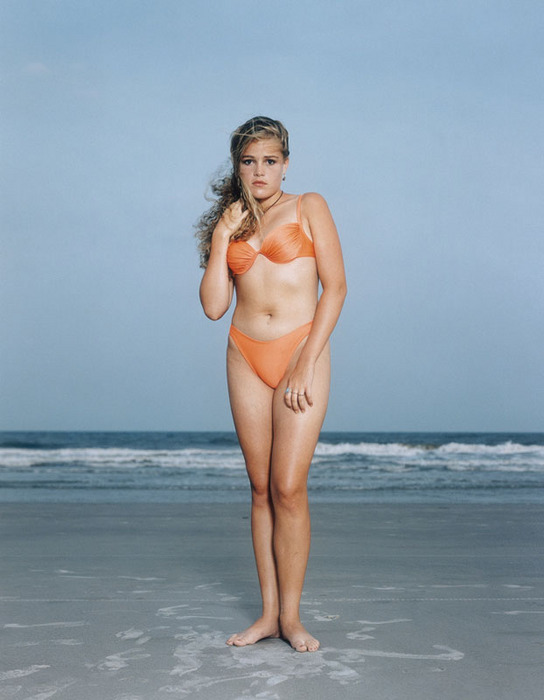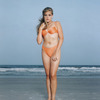Meditations on Photographs: Hilton Head Island, South Carolina, USA June 24 1992 by Rineke Dijkstra

We have abandoned our belief in ancient myths and folk tales, we have replaced them with our own, modern, presumably enlightened ones. There is no more goddess Venus, there is the razor instead or the pop song (enjoy counting the ancient myths in this version). Here then is our Venus, photographed by Rineke Dijkstra. Reflecting our times, our Venus is anonymous, but we get to find out where and when the photograph was taken: Hilton Head Island, South Carolina, USA June 24 1992. (more)
It is worthwhile noting the similarities in the poses of the young woman in the photograph and of Venus in Sandro Botticelli’s The Birth of Venus: Botticelli’s Venus is nude, standing on an oversized shell, using her long blond hair and arms and hands for some measure of modesty. Dijkstra’s Venus is wearing a bikini, using her blond hair and arms and hands for, well, photographic effect, I suppose. The poses are very similar, yet there are some minor differences, in particular the leg to support the contrapposto stance (left in Botticelli’s, right in Dijkstra’s), and the side used to drape the hair over the shoulder (again left in Botticelli’s, right in Dijkstra’s).
But the main difference is, of course, that Botticelli’s Venus is very much at ease, whereas Dijkstra’s is not at all. Botticelli’s Venus is a goddess, after all, literally a goddess (explaining all the improbable stuff in the painting, such as the origin of the wind, the huge shell, the fact that Venus can balance easily even though physics would tell us she would fall over etc.). Dijkstra’s Venus is mortal, just like the rest of us. Faced with all kinds of uncertainties - adolescence as well as an unusual camera operated by someone who, I must assume, betrays here foreign origin through an accent - the Hilton Head Island Venus is putting on a brave face, just barely.
It is a very endearing photograph in part because of that: Everything about it feels very real. It peeks into the human condition, the somewhat unusual pose notwithstanding. Somehow, for this short moment it took to produce a photograph with a 4x5 camera, the world, or at least this beach, has become a stage, and this young woman finds herself right at its center. What to do? Maybe best to do as told, at least so that the photo comes out right.
Also, and this might be just a very contemporary reading, Botticelli’s Venus has a shell to stand on, whereas for this real-world Venus, the world is her oyster. At least that’s what we’re being told, that’s what we want to believe in: In this world, everything is possible, we just have to believe in it, we just have to want it. (Our contemporary myths somehow just don’t have the elegance and beauty of the ancient ones)
Of all of the photographer’s work, with the exception maybe of the portraits of women shortly after giving birth, the beach portraits are my favourite images. They reference part of photography’s history, while having become its own photographic reference. They have contributed to establishing a more contemporary photographic sensitivity, one moving away from using obvious effect, embracing inherent effect. Their strength is derived not from hitting you over the head, but instead from sneaking into your subconscious.
You could imagine hanging one of these photographs on the wall, and every time you’d look at it again you’d find something else to see - these kinds of photographs will not become furniture that happens to hang on the wall.
How does this photograph do that, though? What is it that makes this photograph special? It is not that there is the maybe obvious reference to Botticelli’s Venus. It can’t be. Not every photograph that references a historical piece of art is destined to become a master piece itself. That would be too easy, too simple. There has got to be something else.
I believe that this photograph achieves its goal simply by refusing to play the visual games we are so used to seeing. We are surrounded by images, day and night, and we have taught ourselves to ignore photographs when we feel someone is trying to manipulate us (as is usually the case). Here, there is no manipulation. In the interaction between the photograph and the viewer it is not the photograph making the effort to define its meaning (as is the case in advertizing, say), it’s us having to make the effort to see.
The photograph offers many pointers that might poke us in certain ways. Unlike Thomas Ruff’s portraits, which truly refuse to give anything away, here we have the beach, the models, who are not adults, yet, but who have stopped being only children, we have, let’s face it, the swimwear. Unlike Ruff’s portraits, which, as much as I like them, never fully move beyond being photographic exercises, here we have photographs designed to be more than that. Actual portraits, not afraid of what the German photographer might consider to be a portrait’s baggage.
Ruff felt compelled to solve his problem by producing huge prints, by trying to produce anonymous photographs. In contrast, Dijkstra doesn’t really need this crutch. The photographs themselves solve the problem: They’re not portraits of specific people, on specific days, at specific locations (the title, I believe, is a red herring). Instead, they make us look inside, they make us feel something. What they portray we must figure out - and what we figure out inevitably contains pieces of ourselves.
 By
By 
